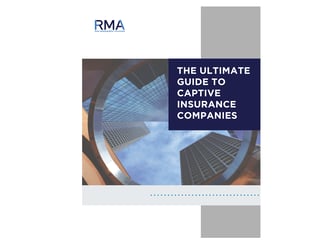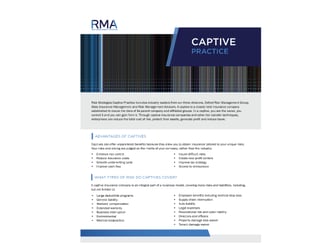The formation of a captive insurance company involves the coordination of many professionals, all working on their own pieces that come together at the time of submission to the regulators. We will detail each of the elements needed for the approval of a captive insurance company. Here's a table to help you understand the process:
|
Steps |
Process |
|---|---|
|
Step 1: Feasibility Study |
Assessing the need and viability of a captive insurance company |
|
Step 2: Jurisdiction Selection |
Choosing the appropriate jurisdiction |
|
Step 3: Business Plan |
Developing a comprehensive business plan |
|
Step 4: Company Formation |
Registering the captive insurance company |
|
Step 5: Insurance License |
Obtaining the necessary insurance license |
|
Step 6: Capitalization Requirement |
Meeting capitalization and solvency |
|
Step 7: Operations |
Implementing operational and risk management |
Step 1: Feasibility Study
The primary goal of a feasibility study is to gather data and analyze it to determine the financial, operational, and strategic feasibility of establishing a captive insurance company. It assesses different aspects to provide insight into whether the formation of the company is viable and aligns with the organization's goals and objectives.
A comprehensive feasibility study includes the following factors:
- Market Assessment
- Financial Analysis
- Operational Analysis
- Risk Assessment
- Legal and Regulatory Compliance
- Implementation Plan
By conducting a thorough feasibility study, organizations can make informed decisions about whether to proceed with the formation of a captive insurance company. It provides valuable insights into the potential benefits, risks, and challenges associated with establishing and maintaining a captive insurance program.
Step 2: Jurisdiction Selection
A comprehensive explanation can be found here: Captives 101 | Captive Domiciles | Things To Consider
Step 3: Business Plan
One of the essential documents in the formation of a captive insurance company is a comprehensive business plan. A business plan plays a crucial role in guiding the overall strategy and operations of the captive insurance company. It provides a roadmap for success and helps outline the company's goals, objectives, and financial projections. A well-developed business plan demonstrates to regulators, stakeholders, and potential reinsurers that the company has a solid foundation and a clear vision for the future.
A business plan for a captive insurance company should include several key components:
- Executive Summary
- Company Description
- Market Analysis
- Risk Management Strategy
- Financial Projections
- Management Team
- Marketing and Sales Strategy
- Compliance and Regulatory Considerations
- Implementation Plan
- Appendix
Creating a comprehensive business plan for a captive insurance company is crucial to establishing a strong foundation and gaining the trust of regulators, reinsurers, and stakeholders. It provides a clear roadmap for success and demonstrates a thorough understanding of the industry and the company's goals and objectives.
Financial Projections
Financial projections play a crucial role in the formation of a captive insurance company. They provide a roadmap for the company's financial future and help stakeholders understand its profitability and sustainability. Financial projections help in making informed decisions about the captive insurance company's feasibility and potential for success. They also serve as a tool for attracting investors and securing financing for the company's operations.
Items to include in financial projections for a captive insurance company
When creating financial projections for a captive insurance company, several key items should be included to provide a comprehensive overview of the company's financial health. These items include:
- Revenue Projections
- Expense Projections
- Investment Income Projections
- Loss Reserves
- Cash Flow Projections
- Balance Sheet Projections
By including these items in the financial projections for a captive insurance company, stakeholders can gain a clear understanding of the company's expected financial performance and make well-informed decisions regarding the company's formation and operations. These projections serve as a valuable tool in assessing the company's financial viability and ensuring its long-term success.
Risk Management Policy
A risk management policy ensures that the captive insurance company is adequately prepared to handle potential risks and minimize their impact on the company's financial stability. It helps establish a proactive approach to risk management, enabling the captive insurance company to identify potential vulnerabilities and take appropriate actions to prevent or minimize losses.
An effective risk management policy includes several key elements that contribute to the overall success of the captive insurance company. These elements often include:
- Risk identification and assessment
- Risk mitigation strategies
- Risk monitoring and reporting
- Compliance and regulatory considerations
A well-defined risk management policy allows a captive insurance company to effectively manage risks and protect its financial stability. The policy provides a roadmap for identifying, assessing, and mitigating risks, making it an essential organizational document in the formation of a captive insurance company.
Investment Policy
An investment policy should include several key components to ensure effective asset management within the captive insurance company. These components may vary depending on the specific needs and goals of the company, but some common elements to consider include:
- Asset Allocation
- Risk Management
- Performance Measurement
- Compliance and Legal Considerations
- Reporting and Documentation
By having a well-defined investment policy, a captive insurance company can effectively manage its assets and investments, mitigate risks, and achieve its financial objectives. It provides a framework for decision-making and ensures transparency and accountability in the management of funds.
Specimen Insurance Policies
When forming a captive insurance company, one of the essential steps is the development of insurance policy wording. These wordings outline the coverage and terms of the insurance policies that the company will offer to its insureds. Here are some key considerations when drafting insurance policy wording:
- Clarity and Precision
- Coverage and Exclusions
- Policy Limits and Deductibles
In addition to the key considerations mentioned above, there are certain legal requirements and best practices that should be followed when drafting insurance policy wording. These include:
- Compliance with Regulatory Standards
- Review by Legal Experts
- Customization for Specific Risks
Overall, insurance policy wording plays a crucial role in the formation of a captive insurance company. It is essential to carefully draft these wordings, considering key considerations and following legal requirements and best practices to ensure clarity, compliance, and adequate coverage for the insured's risks.
Step 4: Draft the Articles of Incorporation
The Articles of Incorporation outline the captive insurance company’s objectives, powers, and limitations. They establish the legal relationship between the company and its shareholders and provide guidelines for decision-making processes and governance. This document is crucial in defining the scope of the captive insurance company's activities and ensuring compliance with applicable regulations and laws.
When drafting the Articles of Incorporation for a captive insurance company, several key provisions should be included. These provisions may vary depending on the jurisdiction and specific requirements, but some common elements typically found in this document are:
- Company Name and Registered Office
- Object Clause
- Share Capital
- Powers and Limitations
- Governance Structure
- Shareholder Rights and Responsibilities
- Dividends and Reserve Funds
- Amendments and Termination
Setting Up A Bank Account
After obtaining the necessary licensing and regulatory approvals, setting up a bank account for the captive insurance company is essential. This account will be used to manage premiums, claims, and other financial transactions related to the captive insurance company. It is advisable to choose a reputable bank that is experienced in working with captive insurance companies. Additionally, depending on the captive insurance company's risk management strategy, it may be necessary to establish investment accounts or reinsurance arrangements.
Step 5: Insurance License
Once the captive insurance company formation process is complete, the next step is to obtain the necessary regulatory licenses. These licenses ensure that the captive insurance company is operating in compliance with the laws and regulations of its domicile jurisdiction. The requirements for obtaining these licenses may vary depending on the jurisdiction, so it is important to research and understand the specific requirements for the chosen domicile.
Step 6: Capitalization Requirement
Before the formation of a captive insurance company is complete, it is essential to meet the capitalization requirements set by the jurisdiction where the captive insurance company is formed. These requirements typically include a minimum amount of capital that must be contributed by the owners or shareholders of the company. The purpose of these requirements is to ensure that the captive insurance company has sufficient financial resources to meet its obligations and provide coverage to its insured parties.
Step 7: Operations
A comprehensive explanation can be found here: Operating a Captive.
Explore
- Solutions
- Captive Insurance
- Captive Insurance Overview
- What is Captive Insurance?
- Definition of Captive Insurance
- Types of Captive Insurance
- Typical Structures of a Captive Insurance Program
- Why Form a Captive Insurance Company?
- Captive Insurance Utilization and Value
- Evaluating a Captive Insurance Program
- How to Setup a Captive Insurance Company
- Operating a Captive Insurance Company
- Captive Insurance Operating Costs
- Retaining Risk vs. Financing Risk
- Risk Distribution Through Captive Insurance
- Taxation of a Captive Insurance Company
- Captive Insurance Domiciles
- News and Insights
- About Us
Practice Leader(s)

Captive Practice Leader, Managing Director

Captive Practice Leader, Managing Director
Max Jong is the Captive Practice Leader and Managing Director at Risk Management Advisors, an alternative risk and captive management firm. Max began his career at Northwestern Mutual in 1994 after graduating from UCLA. Over 12 years, he built a successful financial services practice while heading up an office overseeing 50 professionals in Los Angeles and Irvine, California. The office was perennially one of the top producing organizations in the Northwestern Mutual system.
Max joined his partners at Risk Management Advisors in 2007 as he began to work with more sophisticated mid-market business owners. RMA specializes in the design, formation, and management of captive insurance companies. There’s also an emphasis on self-funded group benefits as well as other creative alternative risk management strategies. The firm assists business owners in better managing their risks without jeopardizing their balance sheets. In 2019, he headed up a merger with Risk Strategies, a Top 10 private national specialty insurance brokerage and consulting firm. Since then, he was appointed as the Captive Practice Leader to oversee the growth and development of the organization.
For five years, Max served as an Independent Director for Fiat Lux Risk and Insurance Company, one of the largest and most sophisticated captive insurance companies. Fiat Lux was established by the University of California Regents to better manage the broad risks of the University of California system.
Max has also been a lifelong supporter of Big Brothers Big Sisters of Greater Los Angeles. He initially volunteered to be a mentor in 1995 and is currently mentoring his second "Little." Max was asked to join the Board of Directors in 2000 and eventually served as their Board Chair. After 20+ years as an active board member, he continues to support the organization by serving as a Trustee.
He is married to Alice, and they’re raising two young children, Hunter and Hayden. Max and Alice are happily married despite her irreparable mistake of going to USC. He loves to travel, golf, and is a hopeful Lakers fan.
Resources








